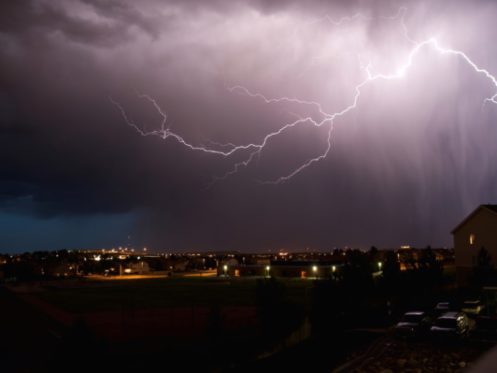Whole-home surge protectors are a smart investment that can protect your electrical system and appliances from damage caused by a spike in electricity. If a major surge hits your home, you are potentially looking at spending hundreds or thousands of dollars to replace your appliances and repair the damage to your electrical system. This is why whole-home surge protectors are such a smart choice as they can help to prevent power spikes from entering your home. If you’re wondering how a whole-home surge protector works, here is everything you need to know.
How a Power Surge Can Affect Your Electrical System and Appliances
A power surge is when there is suddenly much more electricity flowing through a circuit. All of your home’s wiring, outlets and switches are only designed to handle a specific amount of power. The same is also true for all electric appliances and devices. If more electricity flows than the wires can handle, it can create serious issues.
Lightning strikes, downed power lines and electrical grid issues can all cause a huge increase in the electricity that flows into your home. This surge can cause wires to overheat and potentially catch fire. The insulation on the wiring may also melt and cause a dangerous short circuit. Any electronic appliances or devices that are plugged in or hard-wired to the electrical system will also be affected. Most commonly, power spikes cause circuit boards and electronic components to melt or burn out.
Understanding Whole-Home Surge Protection
A whole-home surge protector is similar to the spike strips most people plug their computers, TVs and other sensitive electronic devices into. The reason that most people use these strips is that they think they will protect their devices if there is a major surge caused by a lightning strike.
Unfortunately, the truth is that spike strips are entirely worthless against lightning strikes or most other external power surges. They simply don’t have a high enough rating to handle this type of major power surge. The only thing they can protect against is damage caused by an internal power surge, which usually results from either the cycling of your appliances or overloading a circuit.
Whole-home surge protectors are mounted inside your home’s main electrical panel, and they work to provide protection to your entire electrical system. The unit works by continuously monitoring the voltage of the current as it enters your home. They also monitor the voltage within your electrical system itself. If the unit detects a dangerous increase in voltage, it blocks the current from flowing through the electrical system.
Surge protectors work by grounding the power, and this is true of both spike strips and whole-home units. Grounding means that they direct the current away from the circuit through a ground wire so that it doesn’t flow through the circuit and cause damage.
All electrical systems have a main ground wire, and each of your outlets also has its own ground wire. Outlets are usually grounded to a metal screw or electrical box, but your main ground wire is grounded to the dirt outside your home. The main ground wire is located inside your main electrical panel. From there, it runs through the exterior of the building where it is connected to a copper ground rod. This copper rod is driven a few feet into the ground.
If the whole-home surge protector activates, it automatically isolates your electrical system and all circuits. The surge protector is connected to the ground wire in your electrical panel. In the event of a power spike, it directs all of the electricity into the ground wire instead of allowing it to flow into your electrical system. All of that electricity then flows into the grounding rod and down into the earth where it instantly dissipates.
What Is a Type 2 Surge Protector?
There are three main types of surge protectors, and they are categorized by which point of the electrical system they are installed at. Type 1 is a point-of-service surge protector, type 2 is a system surge protector and type 3 is a point-of-use protector. Both type 1 and type 2 are technically whole-home surge protectors, but there are still a few major differences between them
A type 1 surge protector works similarly to a type 2 except that is mounted at the utility pole and connects to the wire that runs from the electric grid to your home. The main difference between a type 1 and a whole-home surge protector is the “clamping” threshold. This refers to how many volts it takes for the protector to activate and block power from flowing through it.
Type 2 whole-home surge protectors have a much lower threshold, which means that they will activate if there is even a fairly small spike in electricity. The much higher clamping threshold on type 1 protectors means that they will only work if there is a major power surge. As a result, they offer far less protection since even a minor spike can still cause serious damage to circuit boards and electrical components.
Type 3 surge protectors are used where the power flows out of an outlet into a cord. For instance, most power strips are type 3 surge protectors. If this type of surge protector detects a spike in electricity, it channels the current into the ground wire inside the outlet similar to how a whole-home unit does with your main ground wire.
How Much Power Can a Whole-Home Surge Protector Handle?
There are many different types of whole-home surge protectors, and some are more powerful than others. The best units will be able to handle at least 40,000 amps. This means that as long as the electricity spike is less than this, the surge protector will work properly. The average lightning strike has around between 5,000 and 30,000 amps, which is why it is always important to choose a surge protector that can handle at least this amount of current.
Some lightning bolts are much more powerful and can contain far more amps. The most powerful lightning strike ever recorded was over 100,000 amps, and there is currently no type of surge protector that could shield your home from this kind of power. If an extremely powerful bolt of lightning strikes your house or a nearby transformer, it will likely send more current surging through the grid than your surge protector can handle.
No whole-home surge protector will ever keep your electrical system 100% safe as there is always a chance that the current will be higher than the unit can protect against. Nonetheless, the chances of a lightning strike carrying more than 40,000 amps hitting your house are extremely low. This means that your home will be fully protected from anything but the most extreme cases.
Whole-Home Surge Protector Installation
If you need whole-home surge protection in Glendale, Christian Brothers Air Conditioning Plumbing Electrical is ready to help. We’ve been serving the area for more than 40 years, and our licensed electricians can ensure your home is protected from power spikes within a few hours. If your home’s electrical system was damaged by a power surge, we can also inspect it from top to bottom and repair any damage. To learn more about the benefits of whole-home surge protection, give us a call today.










